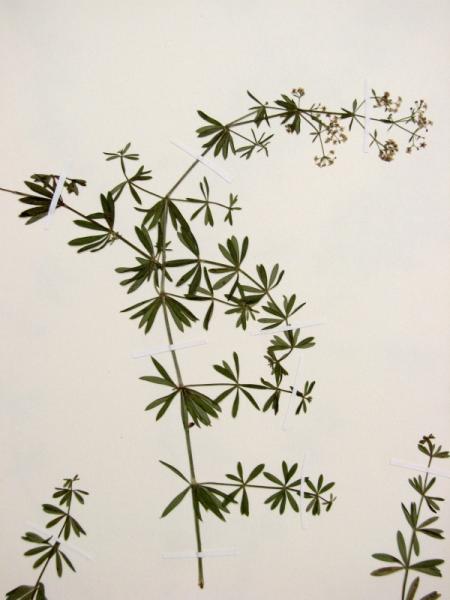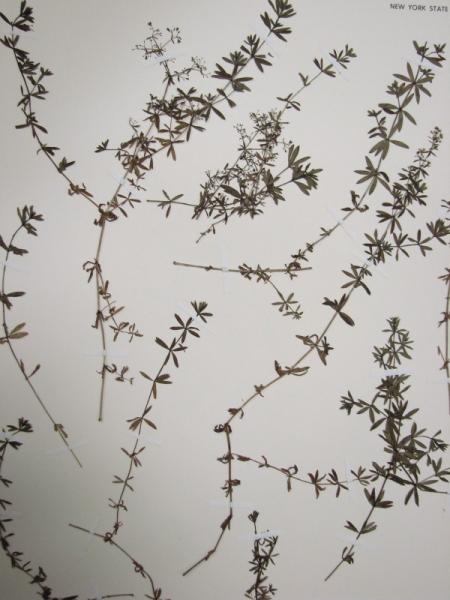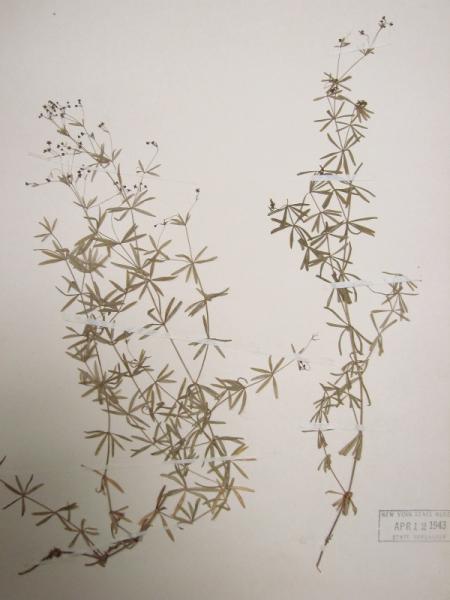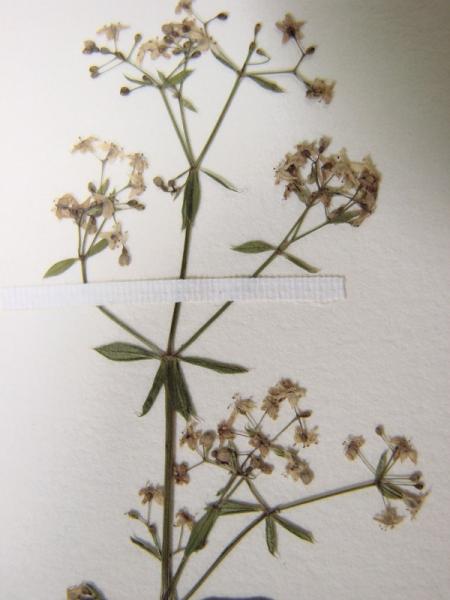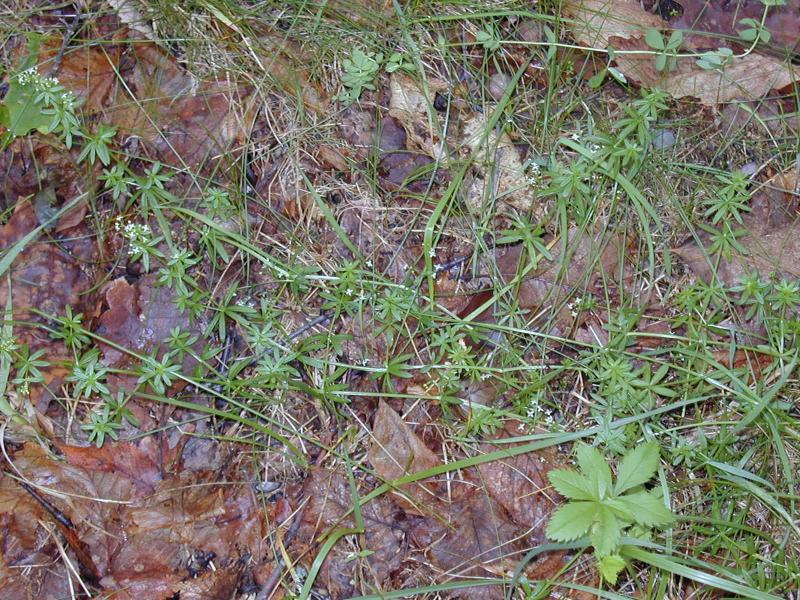Shining Bedstraw
Galium concinnum Torr. & Gray
- Class
- Dicotyledoneae (Dicots)
- Family
- Rubiaceae (Madder Family)
- State Protection
- Endangered
Listed as Endangered by New York State: in imminent danger of extirpation in New York. For animals, taking, importation, transportation, or possession is prohibited, except under license or permit. For plants, removal or damage without the consent of the landowner is prohibited.
- Federal Protection
- Not Listed
- State Conservation Status Rank
- S1
Critically Imperiled in New York - Especially vulnerable to disappearing from New York due to extreme rarity or other factors; typically 5 or fewer populations or locations in New York, very few individuals, very restricted range, very few remaining acres (or miles of stream), and/or very steep declines.
- Global Conservation Status Rank
- G5
Secure globally - Common in the world; widespread and abundant (but may be rare in some parts of its range).
Summary
Did you know?
The genus name Galium comes from the Greek word "gala" or milk and refers to the ability of some species of Galium to curdle milk. The species name is from the Latin "concinnus" meaning well-arranged, skillfully joined, beautiful, or striking. In full flower this species is one of the most beautiful of the Galium species but since New York is on the eastern edge of its range it does not attain the size and beauty of the plants of the Midwest.
State Ranking Justification
There are three existing populations but all of them are small and we lack a complete understanding of their threats and management issues. There are three additional historical locations, but one of them is probably extirpated.
Short-term Trends
The known populations have not been resurveyed to evaluate short-term trends.
Long-term Trends
This species has never been common in New York with only four historical records. One historical record has been relocated and one has not, while two new records have been found but there is little information on their condition and size.
Conservation and Management
Threats
Habitat destruction by housing developments is the greatest threat to this plant. Its upland, woodland habitat is often not protected from development.
Conservation Strategies and Management Practices
Prevent habitat destruction by protecting woodland buffers around populations. Prevent introduction or remove invasive woodland species such as barberry, garlic mustard, or shrub honeysuckle.
Research Needs
The habitat preference is not well understood and more research is needed to help narrow the possibilities of areas to survey and to refine predictive models. Identification characters are difficult to observe and more characters are needed to help develop search images.
Habitat
Habitat
In New York this species has been found in Hemlock-Northern Hardwood and Oak-Hickory forests, as well as along roadsides, trails, and riverside meadows. More information on habitat requirements in the state is needed (New York Natural Heritage Program 2007). Deciduous woods, including beech-maple and oak hickory; banks, swampy ground along streams (Voss 1996). Dry woods (Gleason and Cronquist 1991). Woods and thickets (Fernald 1970).
Associated Ecological Communities
- Beech-maple mesic forest*
(guide)
A hardwood forest with sugar maple and American beech codominant. This is a broadly defined community type with several variants. These forests occur on moist, well-drained, usually acid soils. Common associates are yellow birch, white ash, hop hornbeam, and red maple.
- Hemlock-northern hardwood forest
(guide)
A mixed forest that typically occurs on middle to lower slopes of ravines, on cool, mid-elevation slopes, and on moist, well-drained sites at the margins of swamps. Eastern hemlock is present and is often the most abundant tree in the forest.
* probable association but not confirmed.
Range
New York State Distribution
All the known, extant sites for this plant in New York are in the Lower Hudson Valley; there are historical records from Monroe and Ontario Counties in the western part of the state.
Global Distribution
Galium concinnum is found from New York and Ontario in the east, south as far as Virginia and Tennessee, and ranges west from Minnesota south to Oklahoma. It is also disjunct to Utah.
Identification Comments
General Description
Galium concinnum is a trailing, perennial herb, 15-60 cm tall. The stems have short, rough, downward-pointing hairs. The leaves on the main stem are in whorls of 6, and are linear, 1-2 cm long, and have an awl-shaped tip. The infloresences are branched 2-3 times, bearing tiny (2.4-3 mm wide) white flowers with 4 petals. The fruit are 1.5-2.3 mm high green smooth capsules.
Best Life Stage for Proper Identification
This species is most easily identified when fruiting, though it may be possible to identify vegetative material.
Similar Species
An occasional specimen of Galium boreale with very small leaves might be mistaken for G. concinnum, but the leaves of G. boreale are all blunt tipped and only 4 per whorl. Depauperate or lax plants of Galium mollugo might also be confused with G. concinnum, but G. concinnum never has more than 6 leaves in a whorl, and its leaves are linear or nearly so, while Galium mollugo has 8-12 leaves whorled at the main nodes. Galium mollugo also is usually erect, and tends to be more of a weedy species of old fields, roadsides and woodland edges.
Best Time to See
Galium concinnum fruits from June to mid-August.
- Vegetative
- Flowering
- Fruiting
The time of year you would expect to find Shining Bedstraw vegetative, flowering, and fruiting in New York.
Shining Bedstraw Images
Images of Similar Species
Taxonomy
Shining Bedstraw
Galium concinnum Torr. & Gray
- Kingdom Plantae
- Phylum Anthophyta
- Class Dicotyledoneae
(Dicots)
- Order Rubiales
- Family Rubiaceae (Madder Family)
- Order Rubiales
- Class Dicotyledoneae
(Dicots)
- Phylum Anthophyta
Additional Resources
Best Identification Reference
Fernald, M.L. 1950. Gray's manual of botany. 8th edition. D. Van Nostrand, New York. 1632 pp.
Other References
Gleason, Henry A. and A. Cronquist. 1991. Manual of Vascular Plants of Northeastern United States and Adjacent Canada. The New York Botanical Garden, Bronx, New York. 910 pp.
Holmgren, Noel. 1998. The Illustrated Companion to Gleason and Cronquist's Manual. Illustrations of the Vascular Plants of Northeastern United States and Adjacent Canada. The New York Botanical Garden, Bronx, New York.
New York Natural Heritage Program. 2010. Biotics database. New York Natural Heritage Program. New York State Department of Environmental Conservation. Albany, NY.
New York Natural Heritage Program. 2024. New York Natural Heritage Program Databases. Albany, NY.
Newcomb, Lawrence. 1977. Newcomb's Wildflower Guide: An Ingenious New Key System for Quick, Positive Field Identification of the Wildflowers, Flowering Shrubs, and Vines of Northeastern and North-Central North America. Little, Brown and Company. Boston.
Tucker, Gordon. 1991. A Key to Bedstraws (Galium, Rubiaceae) in New York State. New York Flora Association Newsletter. October, 1991. New York State Museum, Albany, NY.
Voss, Edward G. 1996. Michigan Flora Part III. Dicots Concluded (Pyrolaceae - Compositae). Cranbrook Institute of Science Bulletin 61 and University of Michigan Herbarium. 622 pp.
Weldy, T. and D. Werier. 2010. New York flora atlas. [S.M. Landry, K.N. Campbell, and L.D. Mabe (original application development), Florida Center for Community Design and Research http://www.fccdr.usf.edu/. University of South Florida http://www.usf.edu/]. New York Flora Association http://newyork.plantatlas.usf.edu/, Albany, New York
Weldy, Troy W. and David Werier. 2005. New York Flora Atlas. [S.M. Landry, K.N. Campbell, and L.D. Mabe (original application development), Florida Center for Community Design and Research. University of South Florida]. New York Flora Association, Albany, NY. Available on the web at (http://newyork.plantatlas.usf.edu/).
Links
About This Guide
Information for this guide was last updated on: January 18, 2008
Please cite this page as:
New York Natural Heritage Program. 2024.
Online Conservation Guide for
Galium concinnum.
Available from: https://guides.nynhp.org/shining-bedstraw/.
Accessed July 27, 2024.
